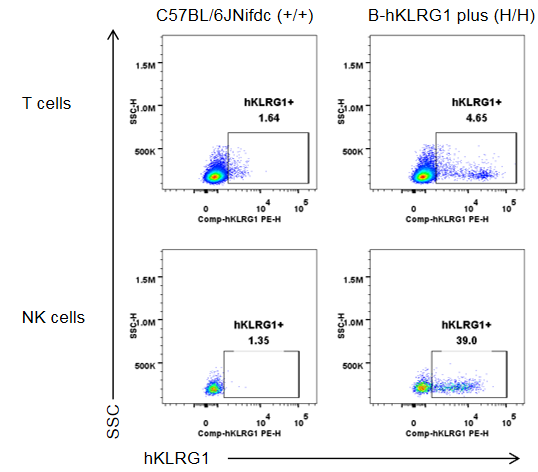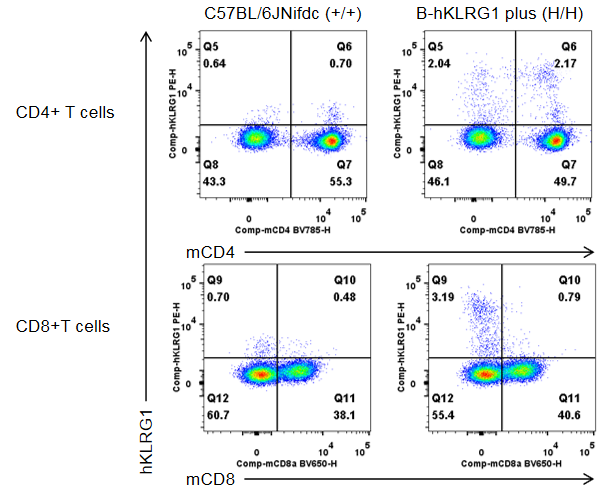B-hKLRG1 mice plus
| Strain Name |
C57BL/6-Klrg1tm3(KLRG1)Bcgen/Bcgen
|
Common Name | B-hKLRG1 mice plus |
| Background | C57BL/6 | Catalog number | 113149 |
|
Aliases |
2F1, MAFA, MAFA-L, CLEC15A, MAFA-2F1, MAFA-LIKE |
||
|
NCBI Gene ID |
10219 | ||
- The protein encoded by this gene belongs to the killer cell lectin-like receptor (KLR) family, which is a group of transmembrane proteins preferentially expressed in NK cells. Studies in mice suggested that the expression of this gene may be regulated by MHC class I molecules.
- The exons 1-5 of mouse Klrg1 gene that encode signal peptide, extracellular domain, transmembrane domain and cytoplasmic region are replaced by human counterparts in B-hKLRG1 mice plus. The promoter and 5’UTR region of the mouse gene are replaced by human counterparts.
- Human KLRG1 was exclusively detectable on NK cells and CD4+T cells of heterozygous B-hKLRG1 mice plus.
- B-hKLRG1 mice plus provide a powerful preclinical model for in vivo evaluation of KLRG1-targeted antibodies.
- Application: this product is used for pharmacodynamics and safety evaluation of KLRG1-targeted antibodies for cancers.
Gene targeting strategy for B-hKLRG1 mice plus. The exons 1-5 of mouse Klrg1 gene that encode signal peptide, extracellular domain, transmembrane domain and cytoplasmic region are replaced by human counterparts in B-hKLRG1 mice plus. The promoter and 5’UTR region of the mouse gene are replaced by human counterparts.

Strain specific KLRG1 expression analysis in homozygous B-hKLRG1 mice plus by flow cytometry. Splenocytes were collected from wild-type C57BL/6 mice(+/+) and homozygous B-hKLRG1 mice plus(H/H), and analyzed by flow cytometry with anti-KLRG1 antibody (eBioscience, 12-9487-42). hKLRG1 was exclusively detectable in T cells and NK cells from homozygous B-hKLRG1 mice plus but not in wild-type mice.

Strain specific KLRG1 expression analysis in homozygous B-hKLRG1 mice plus by flow cytometry. Splenocytes were collected from wild-type C57BL/6 mice(+/+) and homozygous B-hKLRG1 mice plus(H/H), and analyzed by flow cytometry with anti-KLRG1 antibody (eBioscience, 12-9487-42). hKLRG1 was exclusively detectable in CD4+ T cells from homozygous B-hKLRG1 mice plus but not in wild-type mice.












 京公网安备:
京公网安备: